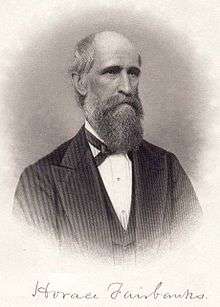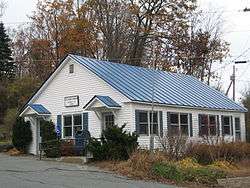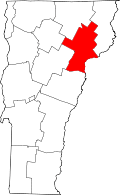Barnet, Vermont
| Barnet, Vermont | |
|---|---|
| Town | |
|
Barnet's post office | |
 Barnet, Vermont | |
 Barnet, Vermont Location in the United States | |
| Coordinates: 44°18′29″N 72°5′0″W / 44.30806°N 72.08333°WCoordinates: 44°18′29″N 72°5′0″W / 44.30806°N 72.08333°W | |
| Country | United States |
| State | Vermont |
| County | Caledonia |
| Area | |
| • Total | 43.6 sq mi (112.9 km2) |
| • Land | 42.2 sq mi (109.4 km2) |
| • Water | 1.3 sq mi (3.4 km2) |
| Elevation | 1,083 ft (330 m) |
| Population (2010) | |
| • Total | 1,708 |
| • Density | 40/sq mi (15.6/km2) |
| Time zone | Eastern (EST) (UTC-5) |
| • Summer (DST) | EDT (UTC-4) |
| ZIP code | 05050 (McIndoe Falls), 05821, 05861 (Passumpsic) |
| Area code(s) | 802 |
| FIPS code | 50-02875[1] |
| GNIS feature ID | 1462034[2] |
| Website |
www |
Barnet is a town in Caledonia County, Vermont, United States. The population was 1,708 at the 2010 census.[3] Barnet contains the locations of Barnet Center, East Barnet, McIndoe Falls, Mosquitoville, Passumpsic and West Barnet. The main settlement of Barnet is recorded as a census-designated place by the U.S. Census Bureau, with a population of 129 at the 2010 census.[4]
Geography
According to the United States Census Bureau, the town has a total area of 43.6 square miles (112.9 km2), of which 42.2 square miles (109.4 km2) is land and 1.3 square miles (3.4 km2), or 3.04%, is water.[3] The Barnet CDP, comprising the town center, has a total area of 0.64 square miles (1.66 km2), of which 0.62 square miles (1.61 km2) is land and 0.019 square miles (0.05 km2), or 2.96%, is water.[4]
The eastern border of the town is the Connecticut River, which is also the boundary between Vermont and New Hampshire. The Passumpsic River enters the Connecticut at East Barnet. Neighboring communities are Ryegate to the south, Groton to the southwest, Peacham to the west, Danville to the northwest, St. Johnsbury to the north, and Waterford, Vermont, to the northeast. Across the Connecticut River is the New Hampshire town of Monroe.
Barnet is traversed from north to south by Interstate 91, with access to the town at Exit 18, West Barnet Road. U.S. Route 5, a two-lane highway, parallels I-91 and passes through the town center.
The highest point in town is 2,103-foot (641 m) Roy Mountain in the southern part of town, east of Harvey Lake.
Climate
This climatic region is typified by large seasonal temperature differences, with warm to hot summers and cold winters. According to the Köppen Climate Classification system, Barnet has a humid continental climate, abbreviated "Dfb" on climate maps.[5]
| Climate data for Barnet, Vermont | |||||||||||||
|---|---|---|---|---|---|---|---|---|---|---|---|---|---|
| Month | Jan | Feb | Mar | Apr | May | Jun | Jul | Aug | Sep | Oct | Nov | Dec | Year |
| Average high °C | −3.2 | −2.1 | 3.9 | 10.7 | 18.9 | 24.4 | 27.0 | 25.9 | 21.8 | 15.3 | 6.6 | −1.3 | 12.3 |
| Daily mean °C | −9.9 | −9.2 | −2.5 | 4.6 | 11.8 | 17.4 | 20.2 | 19.1 | 15.0 | 8.7 | 1.7 | −6.7 | 5.8 |
| Average low °C | −16.6 | −16.4 | −9.0 | −1.5 | 4.6 | 10.3 | 13.3 | 12.3 | 8.3 | 2.1 | −3.2 | −12.1 | −0.7 |
| Average precipitation mm | 51 | 48 | 5 | 72 | 83 | 84 | 98 | 89 | 83 | 78 | 86 | 62 | 888 |
| Average snowfall cm | 43.9 | 46.5 | 29.5 | 7.4 | 0.2 | — | — | — | — | 0.2 | 13.2 | 37.9 | 179.1 |
| Average high °F | 26.2 | 28.2 | 39 | 51.3 | 66 | 75.9 | 80.6 | 78.6 | 71.2 | 59.5 | 43.9 | 29.7 | 54.1 |
| Daily mean °F | 14.2 | 15.4 | 27.5 | 40.3 | 53.2 | 63.3 | 68.4 | 66.4 | 59 | 47.7 | 35.1 | 19.9 | 42.4 |
| Average low °F | 2.1 | 2.5 | 15.8 | 29.3 | 40.3 | 50.5 | 55.9 | 54.1 | 46.9 | 35.8 | 26.2 | 10.2 | 30.7 |
| Average precipitation inches | 2.01 | 1.89 | 0.2 | 2.83 | 3.27 | 3.31 | 3.86 | 3.5 | 3.27 | 3.07 | 3.39 | 2.44 | 34.96 |
| Average snowfall inches | 17.28 | 18.31 | 11.61 | 2.91 | 0.08 | — | — | — | — | 0.08 | 5.2 | 14.92 | 70.51 |
| Average precipitation days | 13 | 12 | 12 | 13 | 13 | 13 | 12 | 11 | 11 | 11 | 14 | 13 | 148 |
| Source: [5] | |||||||||||||
Demographics
| Historical population | |||
|---|---|---|---|
| Census | Pop. | %± | |
| 1790 | 477 | — | |
| 1800 | 858 | 79.9% | |
| 1810 | 1,301 | 51.6% | |
| 1820 | 1,488 | 14.4% | |
| 1830 | 1,764 | 18.5% | |
| 1840 | 2,030 | 15.1% | |
| 1850 | 2,521 | 24.2% | |
| 1860 | 1,994 | −20.9% | |
| 1870 | 1,945 | −2.5% | |
| 1880 | 1,907 | −2.0% | |
| 1890 | 1,897 | −0.5% | |
| 1900 | 1,763 | −7.1% | |
| 1910 | 1,707 | −3.2% | |
| 1920 | 1,685 | −1.3% | |
| 1930 | 2,604 | 54.5% | |
| 1940 | 1,596 | −38.7% | |
| 1950 | 1,425 | −10.7% | |
| 1960 | 1,445 | 1.4% | |
| 1970 | 1,342 | −7.1% | |
| 1980 | 1,338 | −0.3% | |
| 1990 | 1,415 | 5.8% | |
| 2000 | 1,690 | 19.4% | |
| 2010 | 1,708 | 1.1% | |
| Est. 2014 | 1,683 | [6] | −1.5% |
| U.S. Decennial Census[7] | |||
As of the census[1] of 2000, there were 1,690 people, 638 households, and 440 families residing in the town. The population density was 39.9 people per square mile (15.4/km2). There were 831 housing units at an average density of 19.6 per square mile (7.6/km2). The racial makeup of the town was 96.75% White, 0.71% African American, 1.01% Native American, 0.47% Asian, 0.06% from other races, and 1.01% from two or more races. Hispanic or Latino of any race were 0.36% of the population.
There were 638 households out of which 32.4% had children under the age of 18 living with them, 58.5% were married couples living together, 7.7% had a female householder with no husband present, and 30.9% were non-families. 26.0% of all households were made up of individuals and 12.5% had someone living alone who was 65 years of age or older. The average household size was 2.57 and the average family size was 3.11.
In the town, the population was spread out with 26.7% under the age of 18, 6.5% from 18 to 24, 25.2% from 25 to 44, 27.5% from 45 to 64, and 14.0% who were 65 years of age or older. The median age was 40 years. For every 100 females there were 100.0 males. For every 100 females age 18 and over, there were 97.1 males.
The median income for a household in the town was $36,089, and the median income for a family was $43,403. Males had a median income of $32,768 versus $23,173 for females. The per capita income for the town was $17,690. About 7.0% of families and 12.1% of the population were below the poverty line, including 17.4% of those under age 18 and 11.2% of those age 65 or over.
History


The town of Barnet, Vermont, originally took its name from the town of Barnet, England.[8]
On September 16, 1763, the town received its charter from the royal governor of New Hampshire, Benning Wentworth.
The first European descendants to work the land and stay in the town were three brothers, Daniel, Jacob, and Elijah Hall, along with Jonathan Fowler. Their homestead was built along the Connecticut River and to the north near McIndoe Falls. Elijah Hall built the first house in Caledonia County in Barnet, near the base of Stevens Falls.[9] Colonel Alexander Harvey came from Dundee, Scotland, for those in the town who wished to find new land in the American colonies. Despite losing contact with almost all of them after the American Revolution broke out, he decided to stay, claiming 7,000 acres (28 km2) of land and a lake, now known as Harvey's Lake.[10]
Two governors of the state of Vermont were from Barnet: Erastus Fairbanks, who served two terms from 1852–1853 and 1860–1861, and his son, Horace Fairbanks, who served from 1876 to 1878. Horace Fairbanks is also known for manufacturing the first platform scale.[11]
Ocean explorer and scuba inventor Jacques Cousteau[12] had influential experiences on Harvey's Lake as a young boy in the early 1920s. While attending a summer camp he experimented with staying underwater by breathing through hollow reeds found in the lake shallows. Though he could not yet swim well, this allowed him to stay underwater for extended periods.
Religion
Christianity
On January 24, 1784, the town of Barnet voted unanimously to make the Presbyterian denomination the official one of the town, as it was "founded on the word of God as expressed in the Confession of Faith, Catechisms Longer and Shorter, with the form of church government agreed upon by the Assembly of Divines at Westminster, and practiced by the Church of Scotland." The United Presbyterian Church was established by Reverend John Huston in 1786.
The Passumpsic Calvinistic Baptist church was first created by a council of neighboring churches on July 1, 1812. The village of Passumpsic was chosen due to its centralized location.
The First Congregational Church of Barnet was created by Reverend David Sutherland in September 1829 after a new brick church had been built. Its first permanent minister was the Reverend Henry Fairbanks. The church which stands now was constructed in 1854.
The earliest Reformed Presbyterian Church in Vermont was organized in Ryegate in October 1798. In the early part of the nineteenth century, a group of members in Barnet built a new meeting house on the land formerly owned by Walter Harvey, and the property has gone by that name since then. The longest-tenured minister was Daniel C. Faris, who served the congregation from 1873 until 1923.[13] The congregation's Barnet branch became a separate congregation on July 9, 1872,[14] and it continued until disorganization in 1970.[15]
Buddhism
In 1970, upon his arrival in North America, Chögyam Trungpa established the teaching center "Tail of the Tiger" (now Karmê Chöling). It was consolidated with others in Colorado in 1973.
Notable people
- George H. Amidon, Vermont State Treasurer
- Taylor Coppenrath, professional basketball player
- Jacques Cousteau, ocean explorer and SCUBA inventor
- Jay Craven, filmmaker; Marlboro College film professor
- Ralph Flanders, mechanical engineer, industrialist and politician
- Luis Guzman, actor
- Chris Hedges, author
- Henry Clay Ide, statesman and judge
- Anne Morrow Lindbergh, author and aviator; died in Passumpsic (2001)[16]
- Harvey T. Moore, Vermont and Wisconsin state legislator, was born in Barnet.[17]
- Benjamin Franklin Stevens, bibliographer
- Henry Stevens, bibliographer
References
- 1 2 "American FactFinder". United States Census Bureau. Archived from the original on September 11, 2013. Retrieved 2008-01-31.
- ↑ "US Board on Geographic Names". United States Geological Survey. 2007-10-25. Retrieved 2008-01-31.
- 1 2 "Geographic Identifiers: 2010 Demographic Profile Data (G001): Barnet town, Caledonia County, Vermont". U.S. Census Bureau, American Factfinder. Retrieved February 4, 2013.
- 1 2 "Geographic Identifiers: 2010 Demographic Profile Data (G001): Barnet CDP, Vermont". U.S. Census Bureau, American Factfinder. Retrieved February 6, 2013.
- 1 2 "Climate summary of Barnet, Vermont". Retrieved May 15, 2015.
- ↑ "Annual Estimates of the Resident Population for Incorporated Places: April 1, 2010 to July 1, 2014". Retrieved June 4, 2015.
- ↑ "U.S. Decennial Census". United States Census Bureau. Archived from the original on May 12, 2015. Retrieved May 16, 2015.
- ↑ Jones-Baker, Doris (2004). Hertfordshire in History: Papers Presented to Lionel Munby. University of Hertfordshire Press. p. 127.
- ↑ Federal Writers Project, WPA for the State of Vermont (1937). Vermont: A Guide to the Green Mountain State. Boston: The Riverside Press. p. 177.
- ↑ Child, Hamilton (1887). Gazetteer of Caledonia and Essex Counties, VT: 1764–1887. Hamilton Child. pp. 133–151.
- ↑ Fairbanks, Lorenzo Sayles (1897). Genealogy of the Fairbanks Family in America 1633–1897. Boston: American Printing and Engraving Company.
- ↑ My Father, the Captain, by Jean-Michel Cousteau, National Geographic Books, 2010, p.21
- ↑ http://www.rootsweb.ancestry.com/~vtcbarne/barnet_churches.htm#WH Ecclesiastical History of the town of Barnet, Vermont
- ↑ Glasgow, W. Melancthon. A History of the Reformed Presbyterian Church in America, part 8. Baltimore: Hill and Harvey, 1888, p. 400. Accessed on 2008-04-24.
- ↑ McBurney, Charles and Beth. Reformed Presbyterian Ministers 1950–1993. Pittsburgh: Crown and Covenant, 1994, p. 225.
- ↑ Wheeler, Scott (June 2010). "Search for /Charles Lindbergh's Kidnapped Son comes to Vermont". Vermont's Northland Journal. 9 (3): 14–15.
- ↑ 'Wisconsin Blue Book 1875,' Biographical Sketch of Harvey Thomas More, p. 312
External links
| Adjacent places of Barnet, Vermont | ||||
|---|---|---|---|---|
 |
Danville | St. Johnsbury | Waterford |  |
| Peacham | |
Littleton, New Hampshire | ||
| ||||
| | ||||
| Groton | Ryegate | Monroe, New Hampshire | ||

